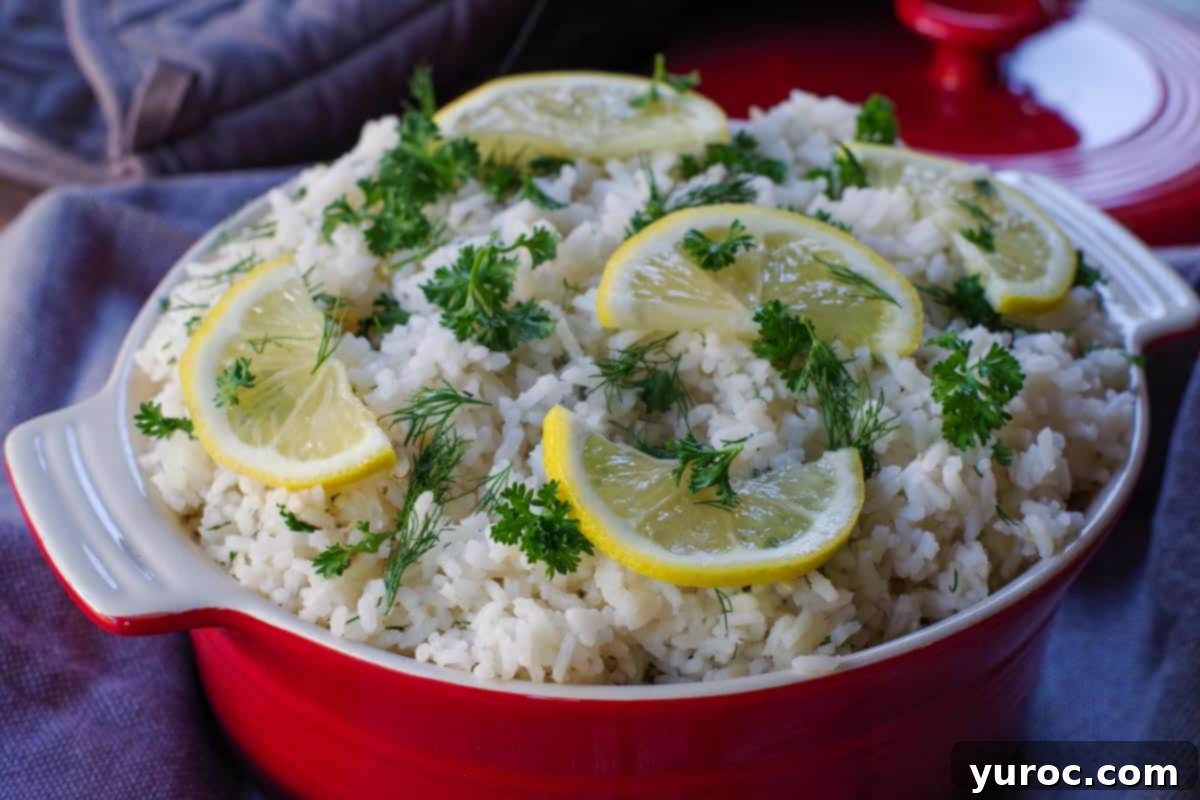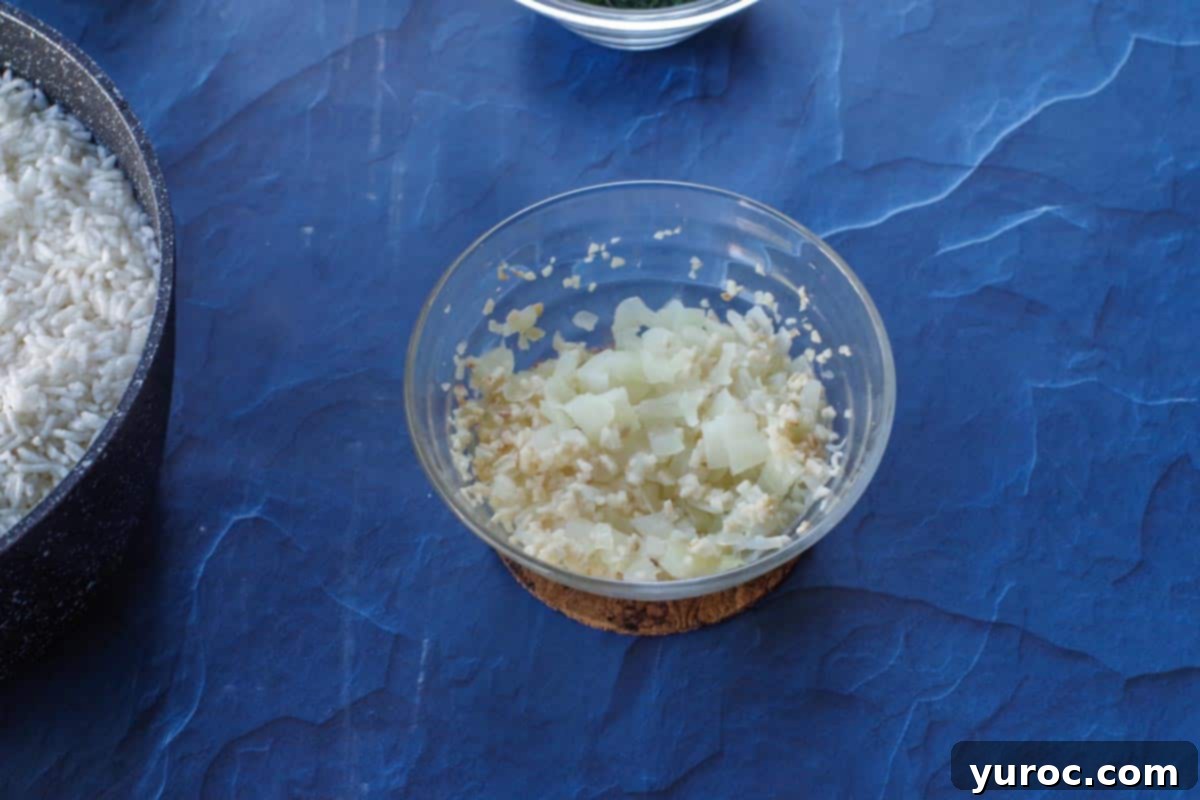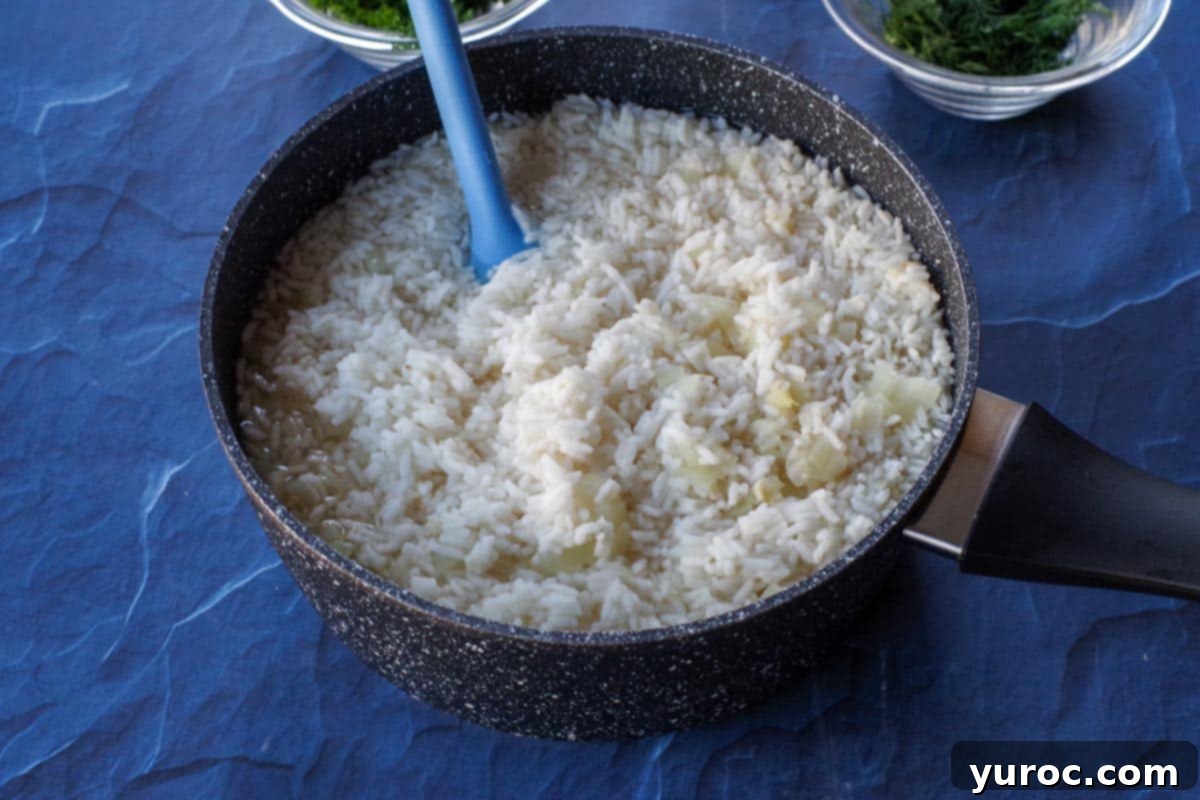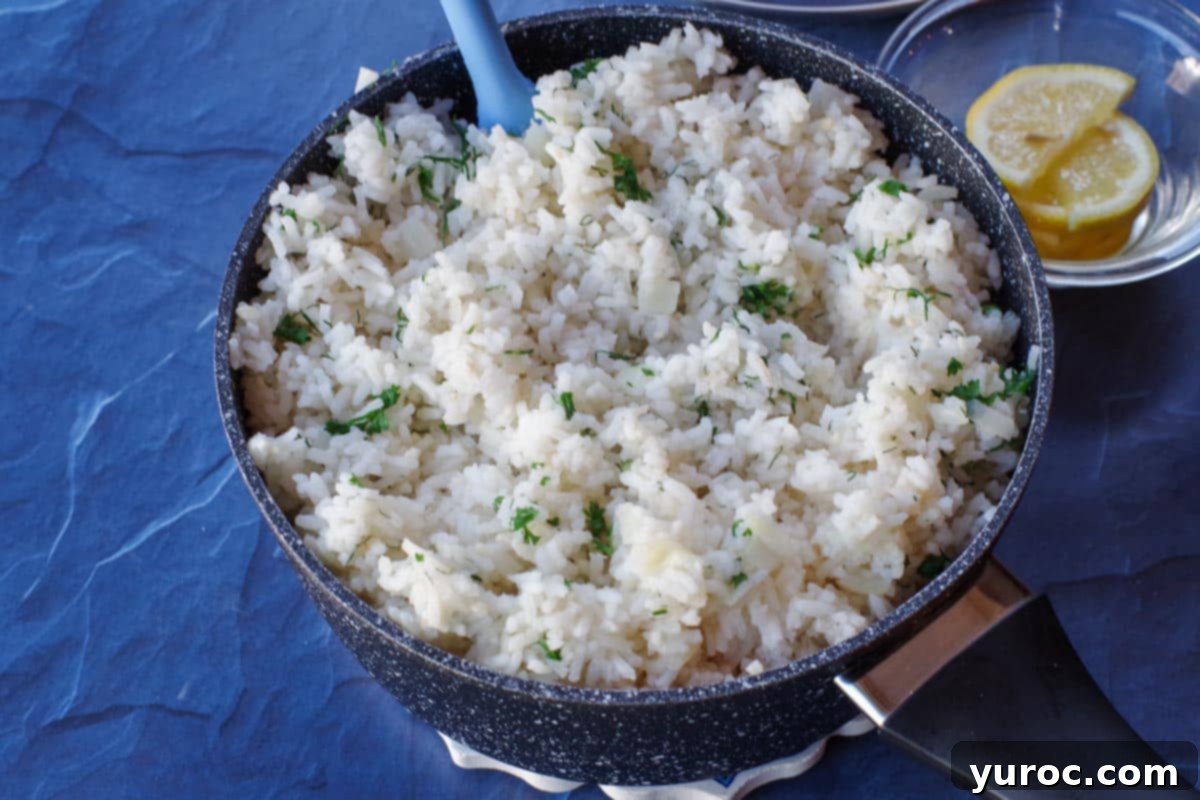Easy Lemon Herb Greek Rice: A Flavorful & Quick Mediterranean Side Dish
Embark on a culinary journey to the heart of the Mediterranean with this incredibly simple yet profoundly flavorful **Easy Lemon Herb Greek Rice** recipe. This dish transcends the ordinary, transforming humble instant rice into a vibrant, aromatic side that captures the essence of traditional Greek cuisine. Forget complicated techniques; my shortcut recipe utilizes quick-cooking instant rice, efficiently microwaved onions, and an abundance of fresh herbs to deliver an authentic taste experience with minimal effort. It’s not just a side; it’s a versatile rice pilaf, destined to become a staple in your kitchen for any meal, any time of year.

My passion for this bright and zesty Lemon Greek Rice blossomed years ago when I worked in bustling Greek restaurants. It was there I discovered the secret to truly spectacular Greek-style rice: an unwavering commitment to fresh lemon and a generous hand with aromatic herbs. These vibrant ingredients aren’t just additions; they are the soul of the dish, infusing every grain with a distinctive tang and earthy freshness. This Greek Rice is perfectly suited for any season, offering a light yet satisfying accompaniment to a wide array of main courses. It’s an impeccable partner for robust flavors like my Grilled Greek Ribs and provides a refreshing counterpoint to the savory notes of Greek Chicken Souvlaki. Its versatility and delightful flavor profile make it an undeniable crowd-pleaser.
This recipe is designed for both novice cooks and seasoned chefs seeking convenience without compromise. The result is a fluffy, fragrant rice that evokes sunny Mediterranean landscapes, ready to complement anything from grilled meats and seafood to simple vegetable platters. Dive in and discover how easily you can bring the vibrant flavors of Greece to your dinner table!
🥘Ingredient Notes: Crafting Authentic Greek Flavors
Achieving the authentic, bright flavors of Greek rice doesn’t require a long list of exotic ingredients. In fact, you only need a handful of simple, readily available items. The key lies in selecting quality components, especially fresh herbs, to unlock the dish’s true potential. Here’s a closer look at what makes this recipe sing:

- Garlic: For ultimate convenience and consistent flavor, minced garlic from a jar is a fantastic shortcut. It saves prep time without sacrificing that essential aromatic foundation. If you prefer, fresh garlic, finely minced, will also work beautifully and offer a slightly sharper flavor.
- Instant Rice: The star of this quick recipe! Instant rice significantly cuts down on cooking time, making this a perfect weeknight side. I typically use Minute Rice, known for its reliable texture and ease of preparation. This choice allows the rich flavors of lemon and herbs to truly shine without a long wait.
- Lemon Juice: While fresh lemon juice is always wonderful, using lemon juice from concentrate is another clever shortcut that maintains the signature bright, tangy profile of Greek rice. It’s convenient to keep on hand and delivers consistent results.
- Fresh Parsley and Fresh Dill: This is where the magic truly happens! The combination of fresh parsley and fresh dill is non-negotiable for achieving that authentic, vibrant Greek taste. Parsley offers a clean, slightly peppery note, while dill brings a distinctive anise-like freshness. Using *both* fresh herbs makes a monumental difference in the final aroma and flavor. Avoid dried herbs if possible, or adjust quantities as noted in the tips.
- Fresh Lemons: Beyond just the juice, fresh lemon slices or zest are crucial for garnish. Not only do they add a beautiful visual appeal, but a squeeze of fresh lemon just before serving amplifies the citrus brightness, truly awakening the flavors of the dish. Don’t skip this critical final touch!
- Chicken Broth: Using chicken broth instead of plain water adds a layer of depth and savory flavor to the rice, enhancing the overall richness of the pilaf. Ensure your broth is good quality, as it forms the liquid base for the rice.
*Refer to the recipe card below for the precise measurements and a comprehensive list of ingredients and quantities for perfect results every time.
📖Variations & Substitutions: Customize Your Greek Rice
One of the beauties of this Greek rice recipe is its adaptability. While the core flavors are irresistible, you can easily tweak it to suit your dietary needs, pantry availability, or simply to experiment with new tastes. Here are some popular variations and smart substitutions:
-
Rice Alternatives:
- Brown Rice: For a healthier, whole-grain option, you can absolutely use instant brown rice. Keep in mind that brown rice typically requires more liquid and a longer cooking time compared to white instant rice. Always refer to the package directions for the specific brown rice you’re using and adjust the liquid and cooking duration accordingly to ensure perfect results.
- Other Rice Types: While the recipe is designed for instant rice for speed, you could adapt it for regular long-grain white rice or even a short-grain variety. This would, however, necessitate significant adjustments to the liquid ratio and cooking method, including potential pre-soaking and a longer simmering time.
-
Lemon Juice Options:
- Fresh Lemon Juice: If you have fresh lemons on hand, using freshly squeezed lemon juice will elevate the flavor even further. Since fresh juice can be more potent and less acidic than concentrate, you’ll typically need to double the amount specified for concentrate and simultaneously reduce the amount of water (or broth) in the recipe by the same volume to maintain the correct liquid balance.
-
Making it Vegetarian or Vegan:
- Vegetable Broth: To transform this into a delicious vegetarian or vegan dish, simply substitute the chicken broth with an equal amount of good quality vegetable broth. This ensures the savory base remains intact while adhering to plant-based dietary preferences.
-
Garlic Preference:
- Fresh Garlic: As mentioned, if you prefer the robust, pungent kick of fresh garlic, mince a few cloves yourself instead of using jarred minced garlic. The cooking method for fresh garlic (microwaving with the onion or sautéing) remains the same.
-
Exciting Add-ins for Enhanced Flavor & Texture:
- Feta Cheese: For a delightful salty and tangy twist, crumble some feta cheese over the warm rice just before serving. The heat will slightly soften the feta, creating pockets of creamy, salty goodness.
- Spinach: Stir in a handful of fresh spinach leaves during the last minute of cooking, or when the rice is resting off the heat. The residual warmth will gently wilt the spinach, adding a boost of color and nutrients without overcooking.
- Toasted Pine Nuts: A sprinkle of lightly toasted pine nuts adds a wonderful crunch and a subtle, buttery flavor that complements the Mediterranean profile.
- Kalamata Olives: For an extra layer of briny, savory depth, chopped Kalamata olives can be stirred in at the end.
Don’t hesitate to get creative with these suggestions. Tailoring the recipe to your liking is part of the fun of cooking!
🔪How to Make Easy Lemon Herb Greek Rice: Step-by-Step Guide
This recipe is designed for speed and simplicity, ensuring a delicious Greek rice pilaf without a fuss. Follow these straightforward steps to create fluffy, aromatic rice in no time:

Begin by combining the finely chopped onion and minced garlic with 1½ tablespoons of water in a microwave-safe bowl. Cook on high for approximately 3 minutes and 30 seconds to 4 minutes, or until the onions are soft and translucent. The exact cooking time may vary slightly depending on the wattage of your microwave, so keep an eye on them. This quick microwave method softens the aromatics and mellows their flavor, creating a perfect base for your rice.
Alternatively, for a traditional approach: If you prefer, you can sauté the chopped onions and garlic in a teaspoon of olive oil in a skillet over medium heat on the stovetop until softened, which typically takes about 5-7 minutes. This method adds a slightly richer, more caramelized flavor to the aromatics.

Once your onions and garlic are prepared, transfer them (if microwaved) into a medium-sized pot or saucepan. Add the instant rice, chicken broth, and lemon juice. Stir all the ingredients together gently to ensure they are well combined. Make sure all the rice grains are submerged in the liquid. This mixture forms the flavorful foundation of your Greek rice pilaf.

Place the pot on your stovetop over medium-high heat. Bring the rice and liquid mixture to a rolling boil, stirring occasionally to prevent sticking and ensure even cooking. Once boiling, immediately reduce the heat to a low simmer (typically setting 3-4 on most stovetops), cover the pot tightly with a lid, and let it cook undisturbed for 5 minutes. After 5 minutes, remove the pot from the heat but keep the lid securely in place. Allow the rice to rest for an additional 5 minutes. This crucial resting period allows the rice grains to fully absorb any remaining moisture and steam, resulting in perfectly light, fluffy, and separate grains.
Finally, uncover the saucepan and gently stir in the fresh chopped parsley and dill. Fluff the rice with a fork, garnish with fresh lemon wedges or zest and a sprinkle of extra herbs if desired, and serve immediately. Enjoy your perfectly cooked, aromatic Greek rice!
Recipe Tips for the Perfect Greek Rice
Even with a simple recipe, a few expert tips can elevate your Greek rice from good to outstanding. Pay attention to these details for the best possible results:
- Prioritize Fresh Herbs for Unmatched Flavor: This cannot be stressed enough – fresh parsley and fresh dill are absolutely critical for achieving the vibrant, authentic taste of Greek cuisine. Their bright, aromatic qualities are truly irreplaceable. If you find yourself without fresh herbs, and must use dried, reduce the quantity significantly (use about ½ of the fresh amount), as dried herbs are far more concentrated in flavor. However, for the ultimate experience, fresh is best.
- Unlock Extra Citrus Punch with Fresh Lemon Zest: While lemon juice provides the essential tang, incorporating fresh lemon zest offers an incredible burst of concentrated citrus aroma and flavor without adding extra liquid or acidity. Use a microplane to gently zest a lemon over the rice just before serving, or even stir a teaspoon into the hot rice along with the herbs. It brightens the entire dish.
- The Golden Rule: Let the Rice Rest Before Fluffing: After the rice has finished cooking on the stovetop and you’ve removed it from the heat, resist the urge to peek or stir immediately. Keeping the lid on and allowing the rice to rest for at least 5 minutes is a game-changer. This steam-absorption period allows the grains to fully swell and separate, preventing stickiness and ensuring a light, fluffy texture that’s characteristic of a perfect pilaf.
- Enhance Depth with a Bay Leaf: For an added layer of subtle, aromatic depth, a common trick in Mediterranean cooking is to toss a single bay leaf into the pot while the rice cooks. Its delicate, slightly floral notes infuse into the rice. Remember to remove the bay leaf before serving, as it’s not meant for consumption.
- Achieve a Creamier Texture: If you desire a slightly richer, creamier rice, stir in a tablespoon of unsalted butter or a generous drizzle of good quality extra virgin olive oil immediately after the rice has rested and before you add the fresh herbs. The residual heat will melt the butter or warm the oil, coating the grains and adding a luxurious mouthfeel.
- Transform it into a Complete One-Pan Meal: This versatile rice can easily be upgraded from a side dish to a hearty main course. Simply stir in pre-cooked protein like shredded chicken, sautéed shrimp, or even vegetarian options like chickpeas or white beans, during the final resting stage or just before serving. This creates a balanced, protein-packed dish that’s perfect for a quick and satisfying dinner.
- Season to Taste: Always taste your rice before serving. Depending on the saltiness of your chicken broth, you might need to add a pinch of salt or a grind of black pepper to perfect the seasoning.
- Don’t Over-stir: During cooking, stir only occasionally when bringing the liquid to a boil. Once covered and simmering, avoid lifting the lid or stirring, as this releases steam and can disrupt the cooking process, leading to less fluffy rice.
🥗 Main Dishes to Serve with Greek Rice
This classic Lemon Herb Greek Rice is incredibly versatile, making it the perfect companion for a wide array of main courses. Its bright, refreshing, and savory notes complement everything from hearty meats to lighter poultry and seafood. Here are some of my favorite pairings that truly shine with this flavorful pilaf:
- Greek Ribs (Grilled): As seen below, the succulent, flavorful Greek Ribs are an absolutely divine match for this rice. The lemon and herb notes cut through the richness of the ribs, creating a perfectly balanced meal.
- Maple Cider Grilled Chicken Kabobs: Serve this Greek rice as a delicious pilaf alongside sweet and savory Maple Cider Grilled Chicken Kabobs. The robust flavors of the chicken are beautifully mellowed by the fresh, zesty rice.
- Easy Cornish Hens with Rosemary Wine Sauce: For a more elegant meal, this rice pilaf is a fantastic accompaniment to tender Cornish Hens with Rosemary Wine Sauce. The subtle herbs in the rice echo the rosemary, while the lemon adds a necessary brightness.
- Greek Chicken Souvlaki: An iconic pairing! This Greek lemon rice pilaf is the quintessential side for tender Greek Chicken Souvlaki skewers. It absorbs all the delicious juices from the chicken, making every bite a delight.
- Greek Chicken Burger Recipe: If you’re looking for something lighter and casual, try serving a scoop of this rice alongside my Greek Chicken Burger. It’s a wonderful alternative to traditional buns and adds a gourmet touch to your burger night.
- Grilled Fish or Shrimp: The light and fresh profile of this rice makes it an ideal complement to any grilled white fish (like cod or snapper) or shrimp.
- Lamb Dishes: Whether it’s roasted lamb shoulder, lamb chops, or a slow-cooked lamb stew, Greek rice provides a refreshing counterpoint to the rich, earthy flavors of lamb.
- Vegetable Entrees: For a vegetarian meal, pair it with roasted vegetables like zucchini, bell peppers, and eggplant, or a hearty Greek salad. The rice acts as a delicious base for fresh produce.

No matter your main course, this Greek rice pilaf will undoubtedly enhance your meal with its captivating flavors and comforting texture.
🌡️Storage & Reheating Tips
Proper storage is key to enjoying your delicious Greek rice for days to come. Here’s how to keep it fresh and flavorful:
- Refrigeration: Store any leftover rice in an airtight container in the refrigerator for up to 4 days. Make sure the rice has cooled completely before transferring it to the container to prevent condensation and maintain texture.
- Freezing: This Greek rice freezes remarkably well for up to 3 months. For best results, allow the rice to cool completely, then transfer it to freezer-safe bags or airtight containers. When freezing, it’s best to omit the fresh lemon slices or zest and additional fresh herbs for garnish until you are ready to serve. These elements are best added fresh after reheating for maximum flavor and presentation.
-
Reheating:
- From Refrigerator: For refrigerated rice, you can reheat it in the microwave with a splash of water or broth (about 1-2 tablespoons per cup of rice) to rehydrate it and prevent it from drying out. Cover and microwave until heated through, stirring halfway. Alternatively, reheat on the stovetop in a covered saucepan over low heat, again with a small amount of liquid, until warmed.
- From Freezer: Thaw frozen rice in the refrigerator overnight. Once thawed, reheat using the same methods as refrigerated rice. If reheating directly from frozen, you may need a bit more liquid and a longer, slower reheating time to ensure even heating.
👪 Serving Size & Adjustments
This recipe is perfectly portioned to make 8 generous servings, making it ideal for family dinners, gatherings, or meal prepping for the week. The beauty of this dish is its flexibility; you can easily scale the recipe up or down to suit your needs:
- Adjusting Servings: To modify the serving size, simply locate the serving number in the recipe card below and click on it. You can then select your desired number of servings (e.g., half, double, or triple the recipe). The ingredient quantities will automatically adjust, saving you the hassle of manual calculations. This feature ensures you always have the right amount of ingredients, whether you’re cooking for one or a crowd.
- Portion Control: Each serving (approx. 1 cup) is light yet satisfying, making it an excellent component of a balanced meal. The clear serving guidelines also assist with portion control, especially for those monitoring their caloric intake.

Recipe FAQs: Your Questions Answered
Have questions about making the perfect Lemon Herb Greek Rice? Here are answers to some of the most common queries:
While fresh parsley and dill truly provide the best and most authentic flavor, you can substitute dried herbs if absolutely necessary. For this recipe, use approximately 1 teaspoon of dried dill and 2 teaspoons of dried parsley in place of the fresh amounts. Remember that dried herbs are more concentrated, so less is more. However, for that vibrant, restaurant-quality taste, fresh is highly recommended.
If your rice is too dry: This usually means it needed a bit more liquid or didn’t get enough resting time. Stir in a small amount of extra hot broth or even just a tablespoon or two of water. Cover the pot tightly again and let it steam on very low heat or off the heat for another 5-10 minutes. The additional moisture will rehydrate the grains.
If your rice is too wet: This could be due to too much liquid or insufficient cooking/resting time. Remove the lid and let the rice sit uncovered for a few minutes. If it’s still quite wet, you can place it back on the stovetop over very low heat (without the lid) for a few minutes, stirring occasionally, to allow some of the excess moisture to evaporate. Be careful not to overcook, which can make it mushy.
Absolutely! This Greek rice makes an excellent base for a more filling meal. You can easily stir in cooked, shredded chicken, sautéed shrimp, or even plant-based proteins like chickpeas or white beans during the final stages of preparation. Add them when you fluff the rice with the herbs, ensuring they are warmed through. This transforms the side dish into a complete, delicious, and protein-packed main course.
Yes, this Greek rice is an excellent option for meal prepping! You can prepare a larger batch and divide it into individual portions for quick lunches or dinners throughout the week. As mentioned in the storage section, it keeps well in the fridge for up to 4 days and can be frozen for up to 3 months. Just remember to add any fresh garnishes (like lemon wedges or extra herbs) right before serving for the best taste and appearance.
You will be delightfully surprised at how this quick and easy recipe consistently produces such wonderfully fluffy, aromatic rice. If you are a lover of authentic Greek flavors and are searching for an effortless yet impressive side dish, or even a light main meal, you will absolutely adore this recipe!
📋More Greek Recipes to Explore
If this Lemon Herb Greek Rice has awakened your palate to the delights of Mediterranean cuisine, you’re in for a treat! Here are more fantastic Greek-inspired recipes from my kitchen that you’re sure to love:
- Greek Style Roasted Potatoes
- Light and Healthy Tzatziki Sauce
- Greek Vegetarian Phyllo Dough Pizza
- Mediterranean Chicken Rice Cups
Did your family ❤️ this recipe? Did you know that commenting and ⭐ rating recipes is one of the best ways to support your favorite recipe creators? If you LOVED this recipe, please take a moment to comment and rate it in the recipe card below, or share your delicious photos on social media using the hashtag #foodmeanderings or by tagging @foodmeanderings! Your feedback means the world and helps others discover these wonderful dishes!


📋Easy Greek Rice (with lemon) Recipe
Ingredients
- 1 small onion, finely chopped
- 1 tablespoon garlic minced * I use from jar
- 1 ½ tablespoons water
- 4 cups instant white rice * I use Minute Rice
- 4 cups chicken broth
- ½ cup lemon juice (from concentrate)
- ¼ cup fresh parsley chopped
- 2 tablespoons fresh dill chopped
Garnish:
- lemon wedges or lemon zest
- additional fresh herbs
Instructions
-
Cook onion and garlic in microwave with water on high for 3 minutes and 30 seconds- 4 minutes until soft (depending on the wattage of your microwave)
-
Add the rice, broth, lemon juice, and cooked garlic and onion to pot.
-
On stovetop, bring rice to a boil in liquid (without lid) stirring at regular intervals. Then cover with lid , turn down to a simmer (3-4 on control) for 5 additional minutes.
-
Remove from heat, keep the lid on, and let it sit for another 5 minutes. The liquid should be fully absorbed when it’s ready.
-
Uncover the saucepan and stir in the parsley and dill.
Garnish
-
Garnish with additional herbs and lemon slices (optional) and serve.
Notes
-
- Use Fresh Herbs for the Best Flavor. Fresh parsley and dill are key to achieving authentic Greek flavor. If you must use dried herbs, use ½ of the fresh amount, as dried herbs are more concentrated.
-
- Use Fresh Lemon Zest for More Citrus Punch. While lemon juice gives the rice its signature tang, adding lemon zest boosts the fresh citrus flavor without making it overly acidic.
-
- Let the Rice Rest Before Fluffing. After cooking, let the rice sit covered for 5 minutes. This allows the grains to fully absorb the moisture, resulting in light, fluffy rice.
-
- Enhance Flavor with a Bay Leaf. For added depth, toss a bay leaf into the rice while it cooks. Remove before serving. This is a common trick in Mediterranean cooking!
-
- Make It Creamier. For a slightly creamier texture, stir in a tablespoon of butter or a drizzle of olive oil after cooking.
-
- Turn It Into a One-Pan Meal. Add cooked chicken, shrimp, or chickpeas to the rice for a complete, protein-packed dish.